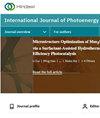A Review of the Technological Advances in the Design of Highly Efficient Perovskite Solar Cells
IF 2.1
4区 工程技术
Q3 CHEMISTRY, PHYSICAL
引用次数: 0
Abstract
The search for renewable and sustainable energy for energy security and better environmental protection against hazardous emissions from petro-based fuels has gained significant momentum in the last decade. Towards this end, energy from the sun has proven to be reliable and inexhaustible. Therefore, better light harvesting technologies have to be sought. Herein, the current trends in the development of perovskite solar cells with a focus on device engineering, band alignment, device fabrication with superior light harvesting properties, and numerical simulation of solar cell architectures are critically reviewed. This work will form the basis for future scientist to have a better scientific background on the design of highly efficient solar cell devices, which are cost-effective to fabricate, highly stable, and eco-friendly. This review presents thorough essential information on perovskite solar cell technology and tracks methodically their technological performance overtime. The photovoltaic (PV) technology can help to reduce pollution related to greenhouse gas emissions, criterion pollutant emissions, and emissions from heavy metals and radioactive species by nearly 90%. Following the introduction of highly efficient perovskite solar cell (PSC) technologies, the problems associated with stability, short life-time and lead-based perovskite solar cell configurations have significantly been minimized. The fabrication and simulation of perovskite solar cells has been made possible with advanced technologies and state-of-the-art computational codes. Furthermore, device simulation strategies have lately been used to understand, select appropriate materials, and gain insights into solar cell devices’ physical behavior in order to improve their performances. Numerical simulation softwares such as the 1-dimenional solar cell capacitance simulator (SCAPS-1D), Silvaco ATLAS, and wx-analysis of microelectronic and photonic structures (wxAMPS) used to understand the device engineering of solar cells are critically discussed. Because of the need to produce charge collection selectivity, hole transport materials (HTMs) as well as electron transport materials (ETMs) constitute essential PSC components. In this work, the synthesis of inorganic HTMs, as well as their characteristics and uses in various PSCs comprising mesoporous and planar designs, are explored in detail. It is anticipated that the performance of inorganic HTLs on PSCs would encourage further research which will have a significant influence on the future designs and fabrication of highly efficient solar cells.高效钙钛矿太阳能电池设计技术进展综述
在过去十年中,寻求可再生和可持续能源以实现能源安全和更好的环境保护,防止石油燃料的有害排放,这一努力势头强劲。为此,来自太阳的能量已被证明是可靠和取之不尽的。因此,必须寻求更好的光采集技术。本文重点评述了钙钛矿太阳能电池的发展趋势,重点是器件工程、能带对准、具有优异光捕获性能的器件制造以及太阳能电池结构的数值模拟。这项工作将为未来的科学家在设计高效太阳能电池设备方面提供更好的科学背景奠定基础,这些设备制造成本效益高、高度稳定且环保。这篇综述提供了关于钙钛矿太阳能电池技术的全面基本信息,并有条不紊地跟踪了它们的技术性能。光伏技术可以帮助将与温室气体排放、标准污染物排放以及重金属和放射性物质排放相关的污染减少近90%。随着高效钙钛矿太阳能电池(PSC)技术的引入,与稳定性、短寿命和铅基钙钛矿太阳能电池配置相关的问题已显著最小化。利用先进的技术和最先进的计算代码,钙钛矿太阳能电池的制造和模拟成为可能。此外,器件模拟策略最近被用于理解、选择合适的材料,并深入了解太阳能电池器件的物理行为,以提高其性能。重点讨论了用于理解太阳能电池器件工程的一维太阳能电池电容模拟器(SCAPS-1D)、Silvaco ATLAS和微电子和光子结构wx分析(wxAMPS)等数值模拟软件。由于需要产生电荷收集选择性,空穴传输材料(HTM)和电子传输材料(ETM)构成了PSC的重要组成部分。在这项工作中,详细探索了无机HTM的合成,以及它们的特性和在包括介孔和平面设计的各种PSC中的用途。预计无机HTL在PSCs上的性能将鼓励进一步的研究,这将对未来高效太阳能电池的设计和制造产生重大影响。
本文章由计算机程序翻译,如有差异,请以英文原文为准。
求助全文
约1分钟内获得全文
求助全文
来源期刊
CiteScore
6.00
自引率
3.10%
发文量
128
审稿时长
3.6 months
期刊介绍:
International Journal of Photoenergy is a peer-reviewed, open access journal that publishes original research articles as well as review articles in all areas of photoenergy. The journal consolidates research activities in photochemistry and solar energy utilization into a single and unique forum for discussing and sharing knowledge.
The journal covers the following topics and applications:
- Photocatalysis
- Photostability and Toxicity of Drugs and UV-Photoprotection
- Solar Energy
- Artificial Light Harvesting Systems
- Photomedicine
- Photo Nanosystems
- Nano Tools for Solar Energy and Photochemistry
- Solar Chemistry
- Photochromism
- Organic Light-Emitting Diodes
- PV Systems
- Nano Structured Solar Cells

 求助内容:
求助内容: 应助结果提醒方式:
应助结果提醒方式:


